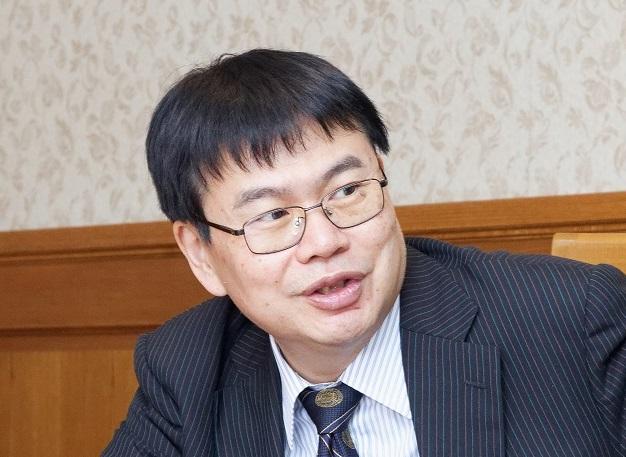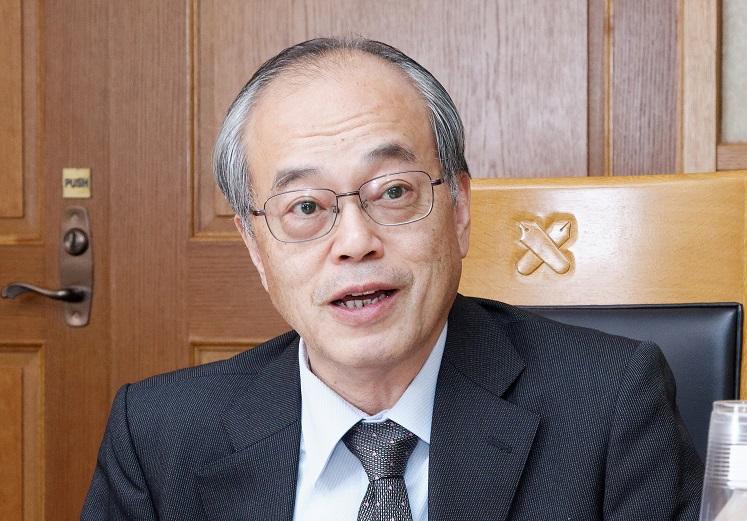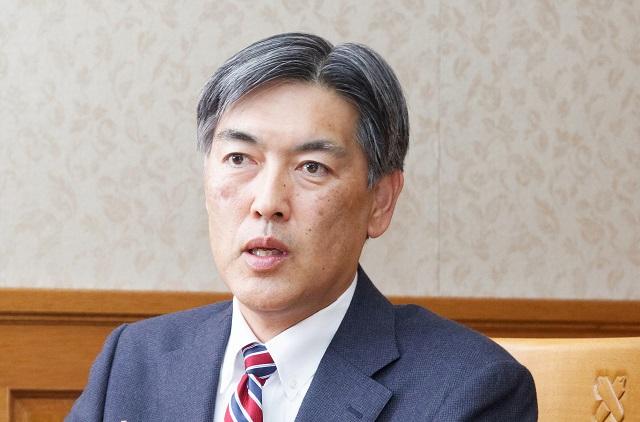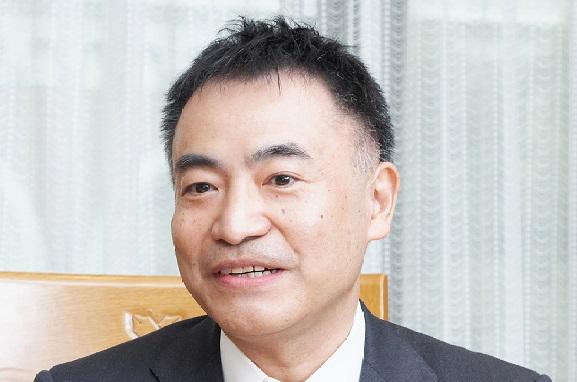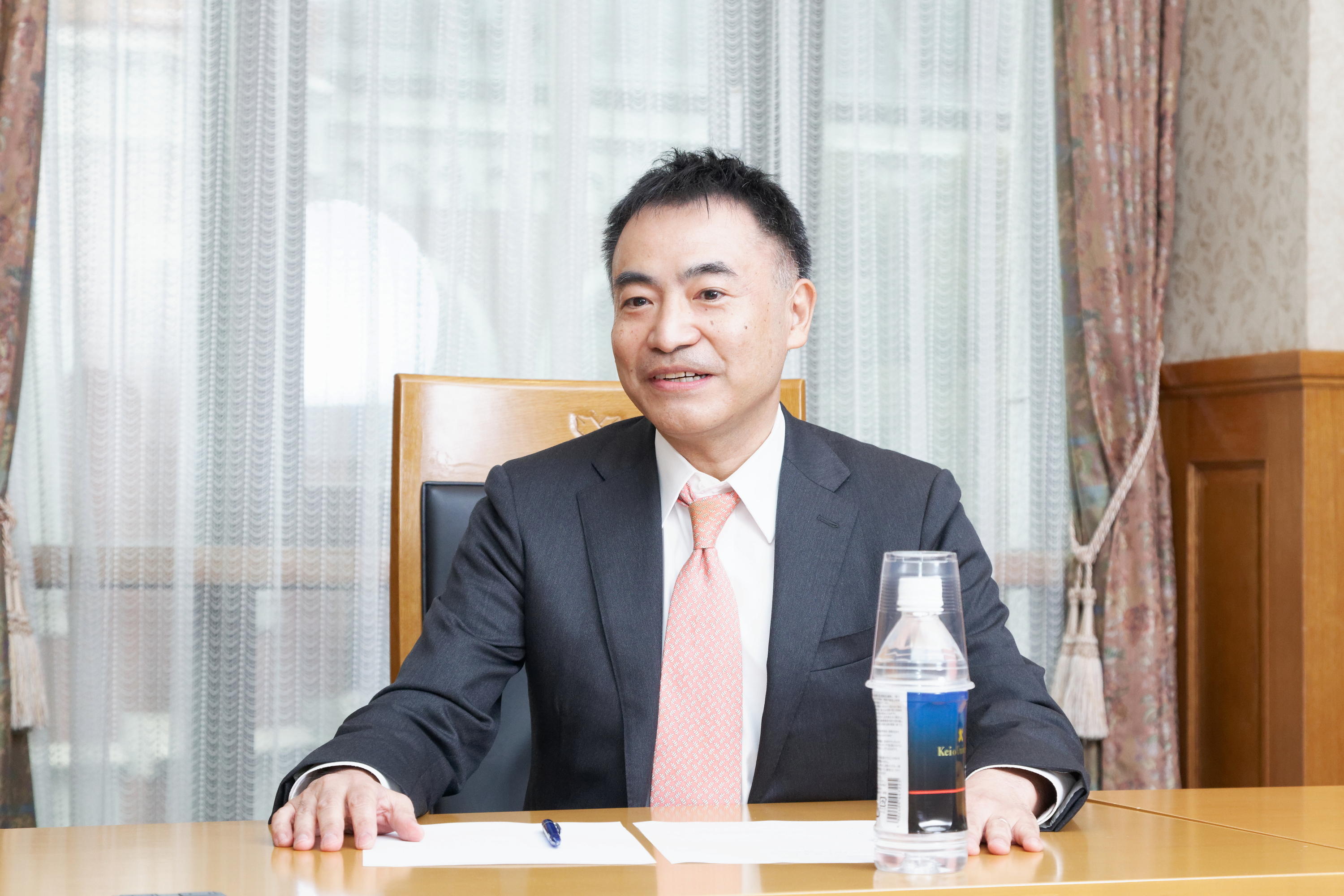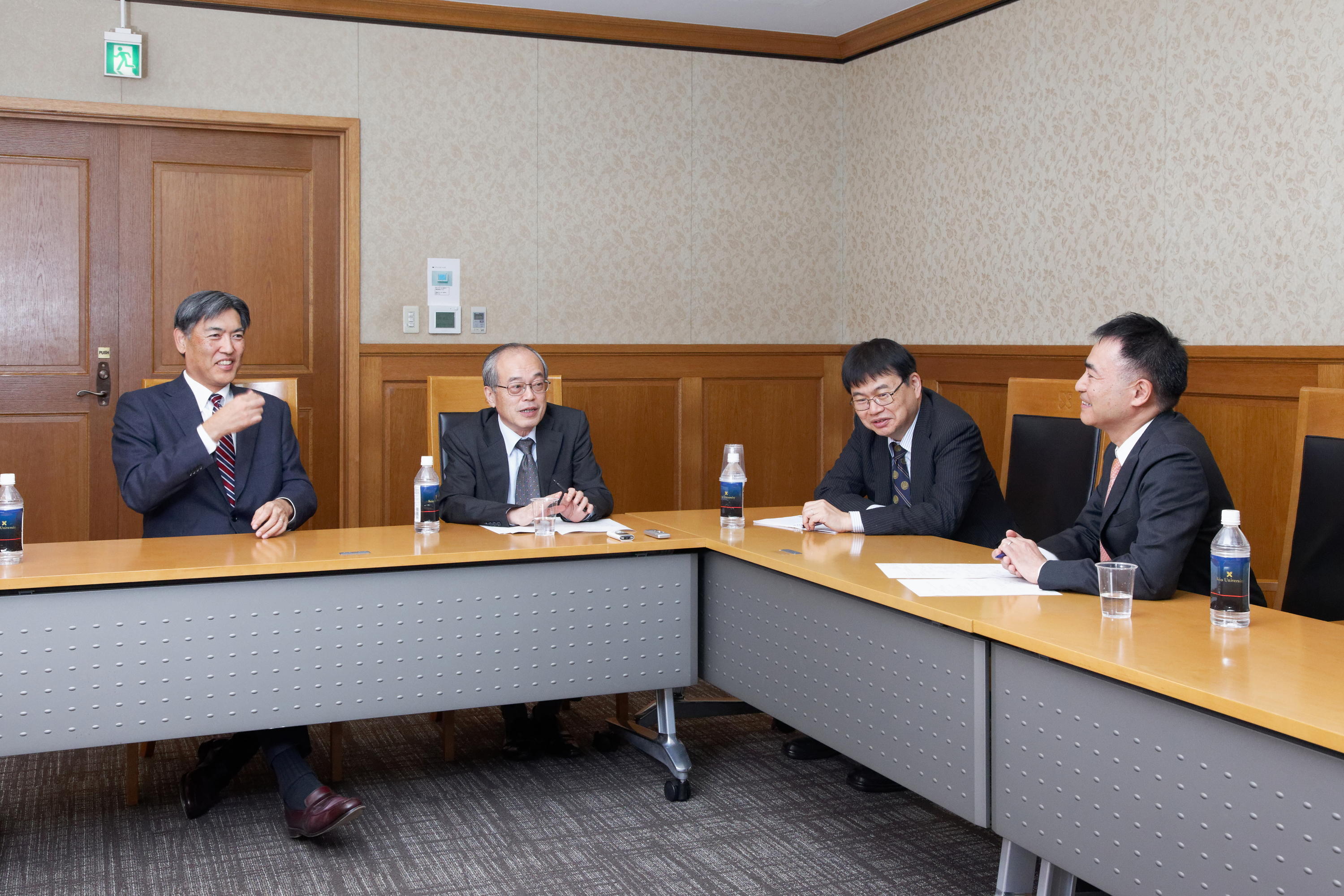Discussions and Interviews
Roundtable Discussion with KGRI Initiative Leaders Moderated by KGRI Director Masato Yasui
- The Future According to
the Keio University Global Research Institute (KGRI) -
the Keio University Global Research Institute (KGRI) -
Longevity Initiative Leader
Hideyuki Okano (Dean, Graduate School of Medicine / Professor, School of Medicine)
Security Initiative Leader
Yutaka Oishi (Vice President / Professor, Faculty of Law and Graduate School of Law)
Creativity Initiative Leader
Kohei Itoh (Professor and Dean, Faculty of Science and Technology and Graduate School of Science and Technology)
Director of the Keio University Global Research Institute (KGRI)
Masato Yasui (Professor, School of Medicine)
YASUI: Keio University has since its founding been engaged in what is known as jitsugaku, a principle of practical learning promulgated by Yukichi Fukuzawa. In the 21st century where we find ourselves today, jitsugaku is increasingly relevant and necessary. To the questions of just how will we see out the 21st century, and what we can do as a university, Keio University's response can be found in the three initiatives of Longevity, Security, and Creativity that it has instituted. It has set itself the objective of rolling out its various research and educational activities within this framework while giving back to society through the outcomes of these activities.
Japan is today in the midst of a super aging society, and this burgeoning tide of aging is a focus of worldwide attention. Various previously unforeseeable events and circumstances are also occurring throughout the world. Our creativity will surely be put to the test as we endeavor to prevail over these issues. I believe that this thinking underlies our decision to institute the Longevity, Security, and Creativity Initiatives. It is also two years since the launch of the Keio University Global Research Institute (KGRI), which is charged with the mission of steadfast advancement of research within the framework of the three initiatives.
I hope that what we discuss today will serve as further food for thought on the nature of the activities that KGRI should facilitate in the ongoing development of this research.
With this in mind, we have asked the three initiative leaders at KGRI to gather here today.
New Cross-Faculty Longevity Research
YASUI: To kick things off, I would like to ask the Longevity Initiative Leader Hideyuki Okano to tell us about the nature of research in the Longevity Initiative and to specify research which is currently underway.
OKANO: Rather than being focused exclusively on medical research, the Longevity Initiative is multifaceted, and concerns itself also with policy recommendations and the technical aspects to support such recommendations. While KGRI itself plays a role in the promotion of research integrating the arts and sciences, I think that this is also an inherent component of the Longevity Initiative.
I have been engaged with issues such as longevity, aging, and dementia from the standpoints of medicine and the life sciences. Meanwhile, on the technical side, Professor Kouhei Ohnishi of the Faculty of Science and Technology tackles such issues as how to manage an aging society through robotics and other technologies. It has been my distinct privilege to work alongside Professor Ohnishi since the outset of the Longevity Initiative. He is an authority in his field with outstanding achievements and accolades, including having been awarded the Medal with the Purple Ribbon for academic excellence from the Japanese Government in 2016.
On the policymaking side, meanwhile, Professor Kohei Komamura of the Faculty of Economics has been investigating from healthcare policy and health economics perspectives. For example, he has been considering the economic effect of delaying the onset of dementia by five years, and the extent of the economic burden on society of dementia as it currently stands. There is an increasing sense of urgency regarding this situation as estimates put this burden at around 14.5 trillion yen annually, equivalent to 3% of GDP. There are inherent difficulties in fully eradicating dementia, so learning how to facilitate early detection and translate this into treatment regimens is a most pressing challenge.
Mr. Haruo Naito, CEO of Eisai Co., Ltd. and a Keio alumnus, has in his professional capacity at Eisai initiated an industry-academia collaboration on dementia research with Keio University known as EKID (Eisai-Keio Innovation Laboratory for Dementia). I think this has also been an important driver for KGRI's research activities.
KGRI also implements autonomous, exploratory research. The Faculty of Pharmacy and Faculty of Science and Technology and others have joined forces to advance cross-campus collaborative research and nurture early career researchers at graduate schools.
If we succeed in developing technologies by these means it could also facilitate the construction of a large database collating medical information and biochemical and molecular biological datasets (also referred to as multi-omics data). The question then presents itself as to how we will employ this big data. I believe its application will be extremely important in orienting dementia research.
I hope that distinguishing the various categories of dementia sufferers and potential sufferers with the Creativity Initiative using AI will allow us to give precise answers to questions such as how many years a person potentially has until the onset of dementia. One even wonders if it will eventually be possible to facilitate diagnostics of cognitive ability using AI. If at the same time this is linked into realizing the early detection and treatment of dementia, we have the potential to tackle what is a national quandary, and indeed one of the major problems confronting humankind.
I believe that specialized medical research on longevity shares various common features with questions of security. We will also pursue potential research avenues with the Security Initiative hereafter.
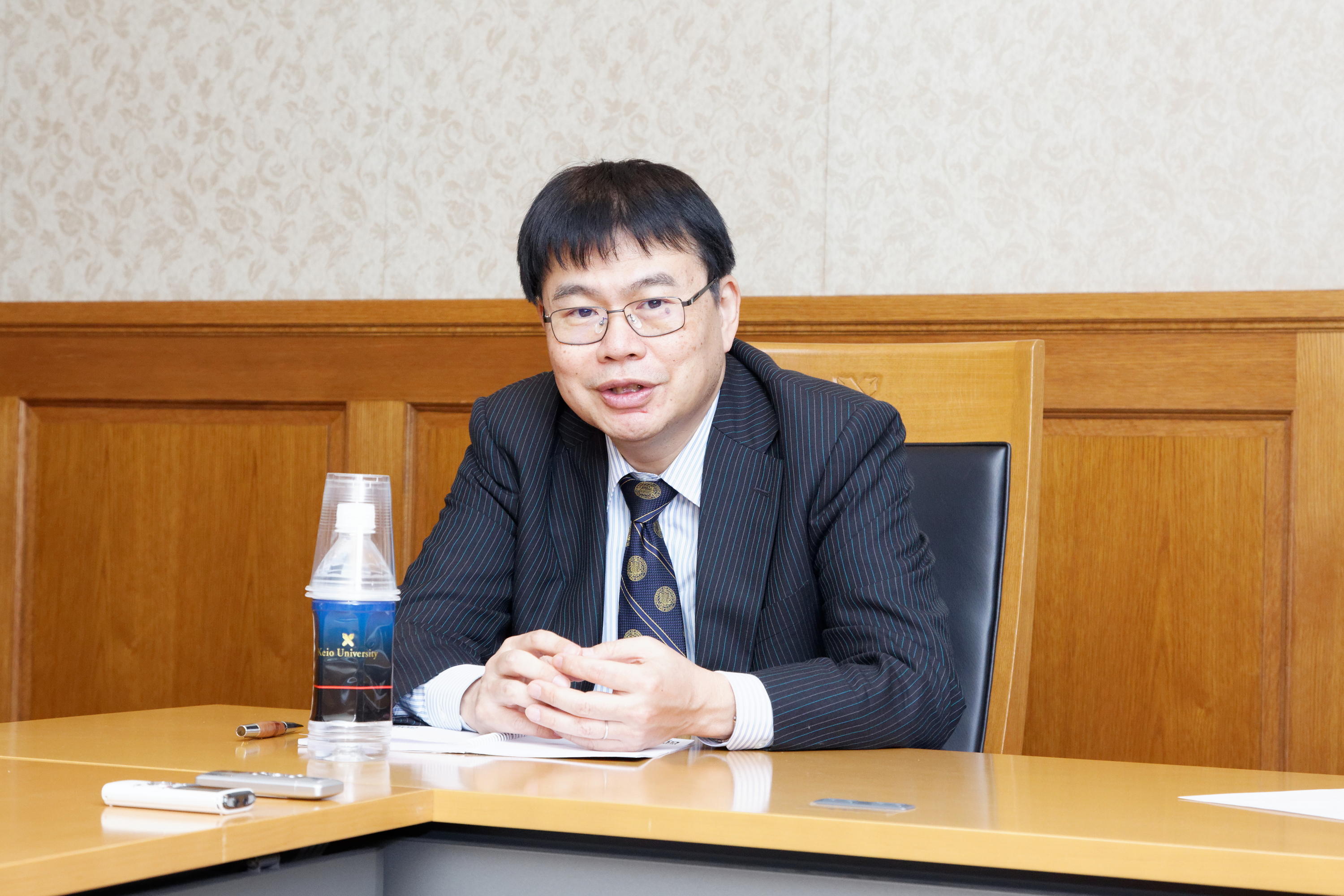
YASUI: Indeed. The types of problems which Japan has within the remit of the Longevity Initiative, will mean engaging with other issues, including those of an environmental and economic nature, rather than being confined by medical approaches. I hope this kind of integrated research can be extended to industry-academia partnerships and tied in with precision deployment of big data in AI and security.
Redefining Security and Peace of Mind
YASUI:I would now like to ask Professor Yutaka Oishi to tell us a little about the nature of research, as well as about some of the projects currently underway in the Security Initiative.OISHI:The Security Initiative has slightly stronger affinities with the social sciences and humanities when compared with the Longevity and Creativity Initiatives. Nevertheless, it goes without saying that we look to deploy research which both integrates the arts and sciences and is of an interdisciplinary nature.
Going back a little, we had the Gulf War in 1990-91; the Great Hanshin Earthquake and Underground Sarin attack in 1995; the 9.11 terrorist attacks in 2001; and the Great East Japan Earthquake of 2011. These have all complicated the issue of Japan as a place of security and peace of mind, the premise upon which Japanese society developed in the decades following the Second World War. We can also not afford to become complacent about security issues in East Asia and on the Korean peninsula, in spite of major progresses. As a result, I believe that the word "Security" as used by this initiative has come to have ever more vital implications both for Japan and the globe.
Pursuing research in the social sciences and humanities in part necessitates numerous discrete and independent fields and projects. The Security Initiative conducts a style of research that brings together our mutual research outcomes having initially deepened our studies and investigations in specialized domains. I believe that the research in the three years to date has begun to produce outcomes. Incidentally, the main projects that are being undertaken concern security issues centered on East Asia, analyses of risk society, and research on various methodologies for managing social systems from the perspective of security for shaping Society 5.0.
The Top Global University Project originally entailed subsidies aimed at the creation of institutional frameworks within the university and education rather than research. However, KGRI was launched by Keio based on the premise that "Education and research are not discrete entities." I think it is thus safe to say that one of KGRI's major characteristics has been the advancement of research deploying independent funding. While the impetus for this was the Top Global University Project, KGRI projects allow Keio University as a whole to lay claim to having independently proposed and implemented research projects.
Realistically, we are probably talking roughly six to seven years before we can genuinely begin to publicize our research outcomes. However, by developing research under various configurations, I believe we can build on the successes of the three years to date and contribute to Keio's capacity to disseminate information on its research through concrete policy recommendations and international exchange in addition to surveys and research.
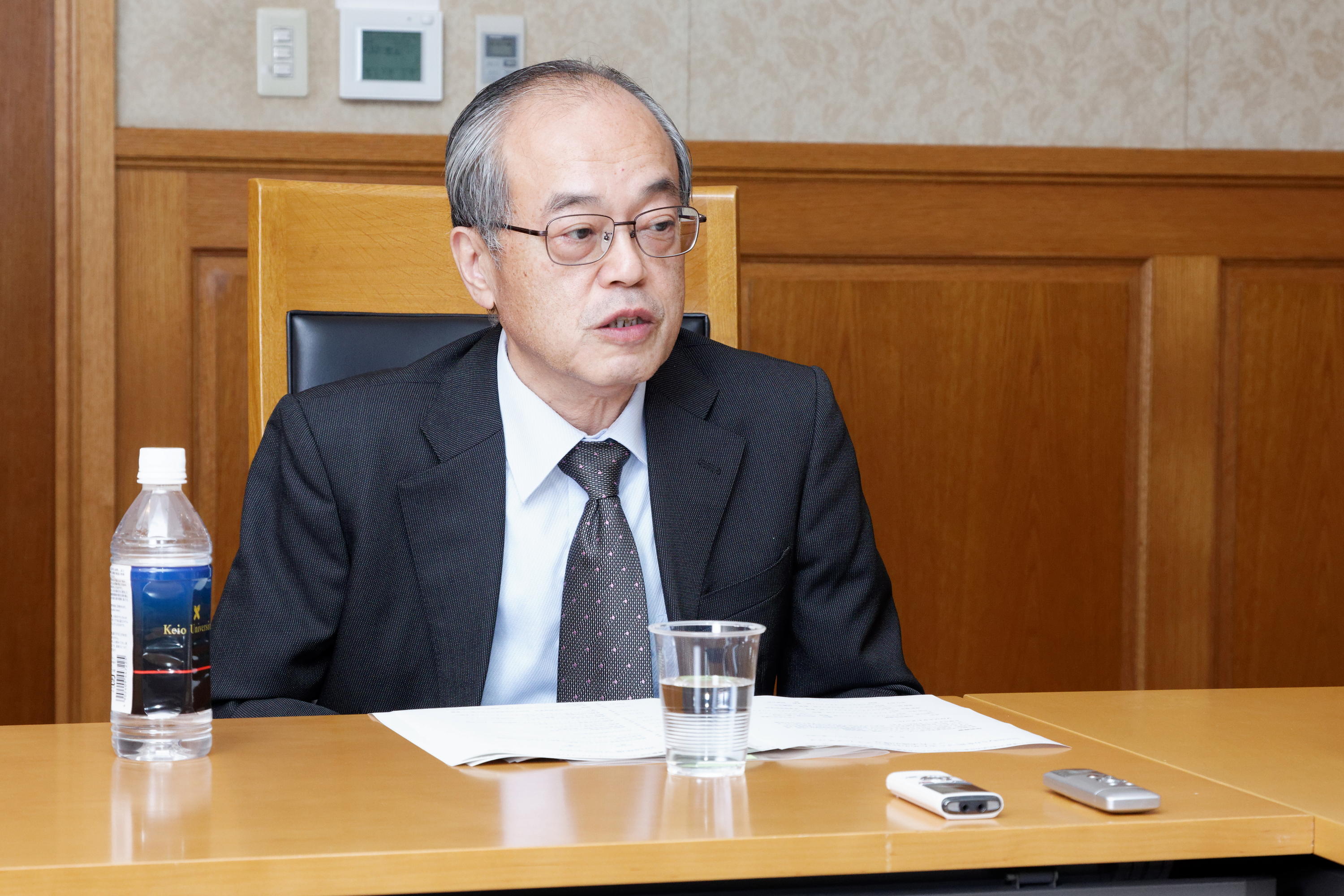
YASUI:Certainly, in the past 20 to 30 years various circumstances have arisen far exceeding our expectations about what we previously imagined to be possible. Although I think we would find that so-called "safe livelihoods" remain of the highest priority in whatever era with which we chose to concern ourselves, I also contend that the importance of this is only set to increase from now on.
Using Our Imagination to "Create" the New
YASUI:I would finally like to ask Professor Kohei Itoh, the Creativity Initiative Leader, to say a few words.ITOH:The Longevity Initiative shares features with the medical sciences, and has set itself the readily-comprehensible objective of improving our quality of life. The Security Initiative too has the easily-understood objective of creating a society of security and peace of mind. So why then, we might ask, did KGRI feel the need to institute a Creativity Initiative. I would explain this by saying that the creation of new things must first be preceded by acts of creativity, which are necessarily imbued with "imagination."
In what ways will newly emerging technologies improve society? Or make it worse? How will we connect our outcomes from academic research in the natural sciences, technology, the social sciences, and the humanities with medical practice and in our communities and lives? The mission that distinguishes research in the Creativity Initiative views productive processes ingrained with imaginative insights as holding the key.
In addition to myself, Professor Kenji Yasuoka of the Faculty of Science and Technology, Professor Takami Matsuda of the Faculty of Letters, and Professor Masahiko Inage of the Graduate School of Media Design are in the driving seat of activities under the Creativity Initiative. Various projects brimming with creativity have been launched over the course of the first three years, and I have intensely scrutinized these in an effort to determine the particular originality possessed by projects at Keio University.
As a result of these deliberations, I am now hoping to make the use of AI foundational to projects in the coming academic year. There are many contending voices asking "Is AI an angel or a devil?" Nevertheless, we must stand poised at the cutting edge of these technologies in order to give them the precise scrutiny which they require and to actively exploit their positive potentials. To take this further, after coming to a thoroughgoing understanding of the potentially deleterious aspects of AI, KGRI must then lead it along virtuous lines.
So, what is it about Keio in particular that will help us achieve this? Nearly 70% of Keio students have a humanities specialization to the 70% of former imperial university students in scientific disciplines. KGRI can help Keio to pave the way for a balanced society by creating a platform for its deployment whereby the majority of students and personnel in the humanities and social sciences can also be seen using AI.
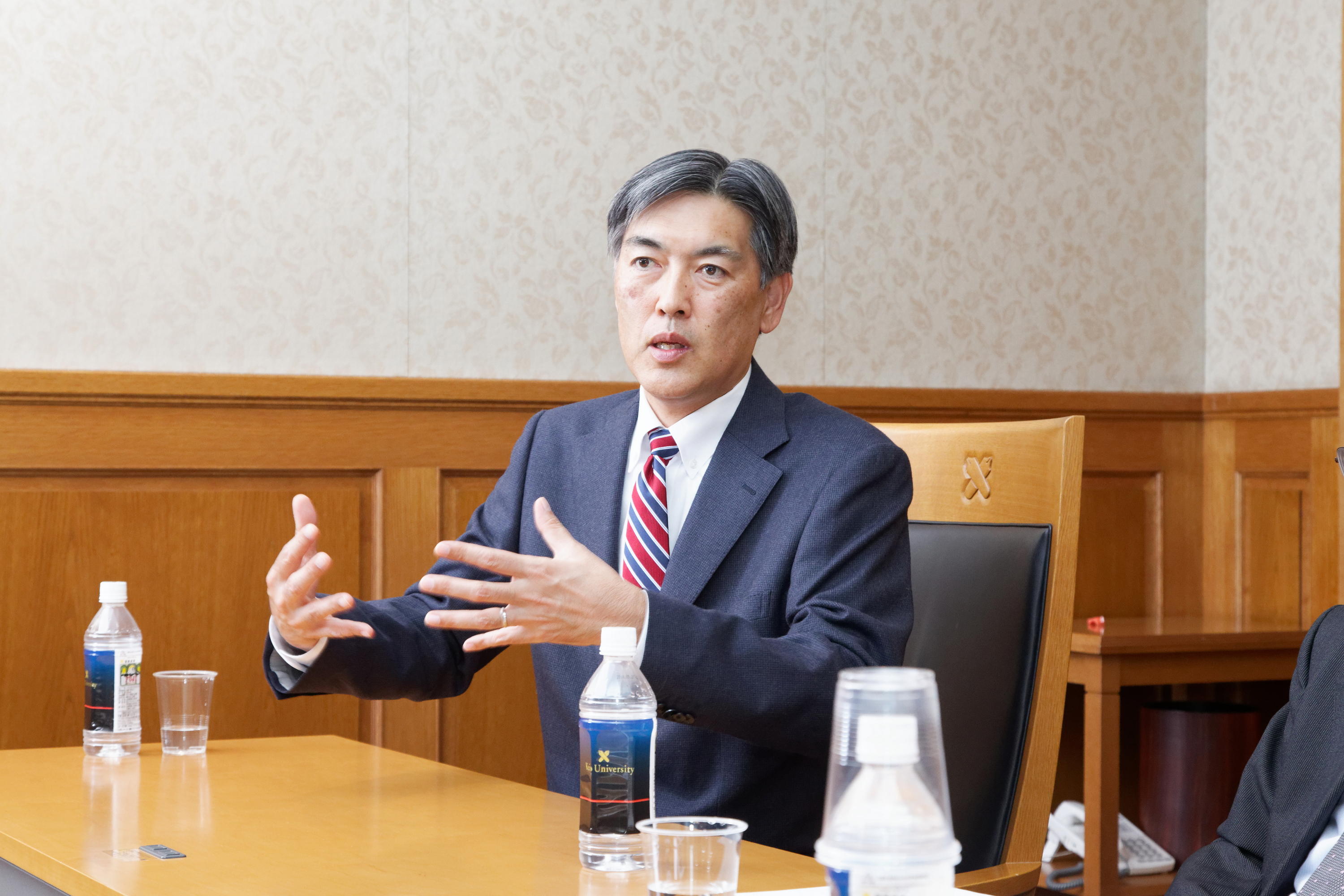
YASUI:Having heard what the three Initiative Leaders have had to say, I think you have identified several specific challenges. Questions, for example, on how to solve the challenges we currently face, what avenues we as a university should pursue to create a better future, and what kinds of initiatives are sought of KGRI. Thank you.
KGRI's Vision for Research, Education, and Nurturing the Next Generation of Outstanding Leaders
YASUI:I think that it is vital that we make it our mission as a university to facilitate the flowering of talented leaders of the next generation while leading cutting-edge research.
I would like to call on you now to each share your thoughts as to how we should go about research, education, and the cultivation of the next generation as informed by your various standpoints as leaders of the three initiatives.
OKANO:Japan, as a country of longevity, now has viable bio-samples of centenarians. These are sought after throughout the world. I believe that Keio University is alone in the world in having as many as 150 of such samples from persons who have lived to ages in excess of 110 years old. We must seek to maximize the possibilities afforded by our having access to these samples. In addition, our early career researchers have the opportunity to learn about technologies not available at Keio at institutions overseas. The various proficiencies which they acquire must be refined and passed on to the next generation. I also think that we should try to create an ecosystem for interactions among personnel at various locations.
We currently have research exchanges with a variety of overseas partners, in particular Washington University, St. Louis. I would be delighted if we could create a research-conducive platform which would further expedite such exchanges. My aspiration would be to create the groundwork for, as it were, "sustainable" personnel exchange. We hope in the near future to establish ties with the Buck Institute, which specializes in aging research.
OISHI:Participation in research briefings and forums overseas, with a focus on early career researchers, has been made easier. As Professor Okano has pointed out, by also having made it possible for many overseas researchers to come to Keio, I have the impression that we are now in a situation where day-to-day exchange with peers from overseas is a reality.
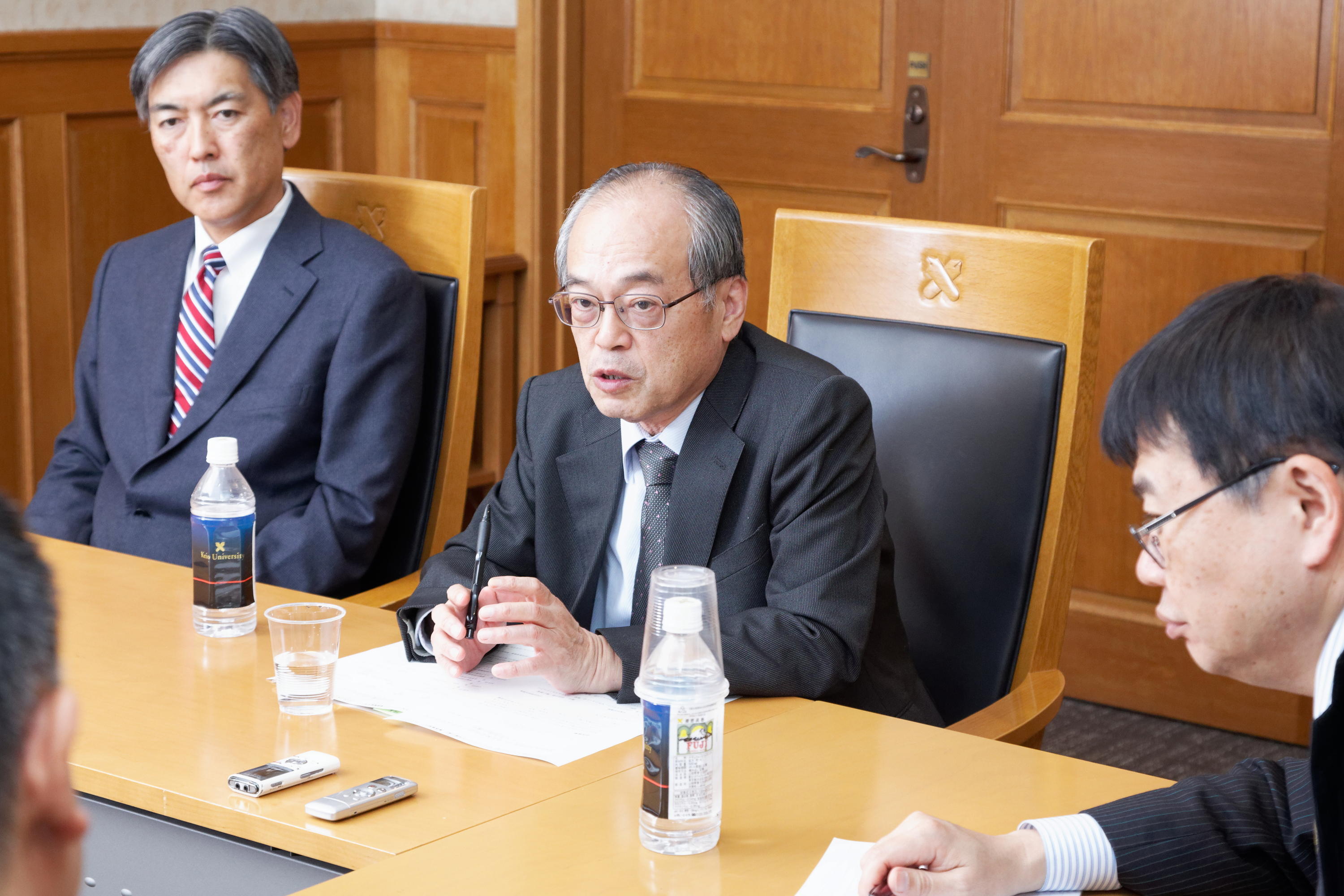
An expanded scope of early career researchers and international students of course means that the summits awaiting us will continue to get higher. I feel that each and every early career researcher now has an appropriate receptacle into which to pour their research efforts, and that this receptacle is gradually filling up. As it stands, our path forward remains incomplete. I nevertheless believe that a viable path towards consolidating the research environment is increasingly within our sights.
Speaking specifically for the Security Initiative, talented researchers at the previous incarnation of KGRI, the Global Security Research Institute (G-SEC), were producing solid outcomes. KGRI is continually building on this groundwork, with an ever-expanding scope of researchers now coming together around the three initiatives. Going forward, I would like to see early career researchers nurtured in an increasingly conducive environment, with such efforts remaining in step with our endeavors to facilitate improvements in the quality of fully-fledged research.
YASUI: Professor Itoh what are your thoughts?
ITOH:It was the aspiration to establish a new communal space on Hiyoshi Campus, the home of seven undergraduate faculties, which came to mind when I was considering the unique contributions KGRI could make.
The Hiyoshi AI and Advanced Programming Room on the first floor of the Fujiyama Memorial Hall (Fujiyama Kinenkan) has been in operation since May of this year, following approval by the Heads of the Hiyoshi Campus faculties. This serves as a venue to encourage autonomous AI and programming activities by Keio students. This entails the necessity to orient students in matters of security and ethical behavior. It will also mean ensuring above all that the room does not remain the exclusive domain of those in scientific disciplines or become a mere vehicle to facilitate procrastination by particular cliques.
This means that we have to make this a space which is also appealing to humanities students. Hereafter, I would like to organize AI contests that transcend the boundaries of the sciences and humanities, such as the hosting of business contests using AI or programing contests for beginners. The foremost aspiration is that this room will become "A place to familiarize Keio students with using AI technologies at an early stage." We could go further and say that those Keio students who have trained in this room will be able to use their expertise to advise professors with a poor affinity for AI or programming as to how it's done.
The technical talents, competencies, and know-how which these students acquire would serve as a model to herald a new era of hangaku-hankyo (learning while teaching, teaching while learning). I think that the attendant contributions via seminars and research will also be an asset in augmenting Keio's research capacities.
With the start-up of the Yagami AI and Advanced Programming Room, I also hope that we will see corresponding facilities set up at the Mita, SFC, Shinanomachi, and Shiba-Kyoritsu campuses in the near future.
YASUI:This would be a good start in expanding the opportunities for young students and researchers to be globally active. With a view to long term prospects, nurturing the next generation in this way would also increase research capacities. I think that we all share this particular aspiration.
Challenge to Reconcile Highly Specialized Research with Integration of the Arts and Sciences
YASUI:When we consider KGRI's desired orientation, the key precepts are integrating the humanities and sciences and interdisciplinary research. However, I think that while the danger is slight, we should remain vigilant in not allowing our overall level to drop.
Professor Oishi, can I ask for your opinion regarding this?

OISHI:I think this question is pivotal. Of course, while research which integrates the sciences and humanities is a core principle, I think it is also imperative to increase wider societal appreciation in specialized domains. Different researchers produce outcomes in their specialist domains that are received favorably by society at large, while these simultaneously converge in facilitating joint interdisciplinary research that integrates the sciences and humanities. I think that both of these aspects should be regarded as imperative.
However, we must acknowledge the reality that the amount of research time available is being negatively impacted by various circumstances. We need to continually enhance the fields in which respective researchers are talented, while suitably acknowledging this point. At the same time, we must commit to achieving interdisciplinary connections.
ITOH:I think we can all agree with Professor Oishi's assertion that improving our reputations in our particular fields is extremely important. However, in the meantime we have to consider if the decreased research hours also signaled by Professor Oishi are a systematic issue at Keio or more a problem related to academic conferences.
I wonder if maintaining the balance of improving reputations with work duties is in fact becoming more difficult.
OISHI:While preparing for academic conferences is extremely important, this is often something which ends up being done on the fly. Our day-to-day duties at Keio are a greater challenge. We see many examples of duties which are treated as necessarily "obligatory" at Japanese universities in recent times running in step with our "essential" duties as a part of the Keio system. This uniform configuration which does not allow for individual variations by researcher or university is among the factors responsible for reductions in the time available for research.
YASUI:Thank you very much for this extremely important lead. I agree that the reduction in time available for research is a very serious problem.
You assumed the duties of Dean of the School of Medicine having already been active as a world-leading neuroscientist. What insights have these experiences afforded you on the ideal configuration for Japanese universities today?
OKANO:In Japan, there is major pressure to perform at a global standard, which is added to by an increase in the amount of paperwork across various domains of university life. This is compounded by the fact that Japan has a chain of administrative processes which must be followed and rubber-stamped by higher-ups. I feel that this is symptomatic of a slavish devotion to bureaucracy. In this I think that Keio is no longer an exception to the norm.
The result is less time dedicated to practical research. I would go so far as to say that this takes the wind out of one's sails. I would be pleased if Keio University could lead the way by putting energy and efforts into prioritizing research and development. Perhaps in fact KGRI's mission at Keio may be to lead by example. We could show the way as to what conditions allow one to perform at one's best.
YASUI:I myself spent over ten years at a university overseas, and on my return to Keio was painfully aware of this doctrinaire attitude to procedure indicated by Professor Okano. I feel that it is extremely important that this issue be tackled if we are to become a research university that can handle ourselves at a global level, and I hope to play my part to ensure that KGRI activities serve to lead the way in resolving this issue. Furthermore, it is my wish that KGRI will become a platform for the dissemination of a success model for nurturing global leaders; that we can point to how to "enjoy research if you do it more like this," and that this is the way to "become a world leader."
KGRI: A platform where researchers from across faculties converge to create the new
YASUI:Thank you for sharing your suggestions on KGRI, including on its latent potential.
Finally, could I ask you all to offer a few words of encouragement for KGRI?
OKANO:I think that it is necessary to expand efforts to familiarize the world at large with KGRI's activities. What is important in making us more attractive to corporate entities is increasing the visibility of KGRI activities from a marketing perspective. This might involve leveraging the Keio Marunouchi City Campus or indeed Mita Campus.
Unique undertakings such as the "School of Medicine Venture Contest" which is implemented by students of the School of Medicine are manifesting one after the other. I hope that by planting these various seeds we will be increasingly able to expedite the course of industry-academia collaboration by inviting private sector entities to do business.
YASUI:Thank you very much. Preparations are underway to disseminate these undertakings to the wider world. I would like to systematically bring each of these to fruition. Professor Oishi where do you stand on this?
OISHI:This may be stating the obvious but we can only do work which is humanly conceivable. It thus strikes me that what is important is to first produce ideas born of daring imagination which exercise our creative capacities. Even if we can realize only half of these, we will likely be able to label this a "successful outcome." Director Yasui, I would like you to further elucidate the policies you believe will help produce even more adventurous ideas than we have seen to date.
YASUI:Certainly. I would describe my aspiration as being the advancement of research integrating the sciences and humanities not freely conceivable within existing frameworks.
Finally, I turn to Professor Itoh to provide a few words
ITOH:Rather than faculty members looking at us sideways and saying "Oh I see, KGRI are up to something or other" which is compounded by the low level of awareness of KGRI at Keio, in the years to come we would like to create a situation whereby we have become a presence and entity which will inspire people to say "I want to take part!" This is our biggest challenge.
I wonder if perhaps KGRI could serve as a platform to engage in dialogues and create alliances across faculties such that we are asking: "What we can to do toward a unifying goal?" We would then have to continually disseminate these dialogues to the world to show the thinking behind these alliances and that this is what we are achieving thanks to these unique and interesting combinations. While such combinations might not immediately produce outcomes, I think that they will be appreciated as long as we are managing to concentrate on the right things.
YASUI:Thank you very much. I hope to engage in dedicated efforts to ensure KGRI grows as an appealing location for many students and researchers at Keio. With so many ideas flying around and KGRI continuing to provide opportunities for ever more highly specialized research, we will proceed to disseminate our outcomes to the world.
Further, my ultimate wish is that young researchers who have learned in such a stimulating environment will fly the nest as the global leaders of the future. In order to achieve this, we must progress as a single unit that integrates KGRI and the different initiatives, as well as dedicate ourselves systemically to specific projects that engage with the challenges you have identified today.
I look forward to working with you all into the future and thank you for taking the time out of your busy schedules to be here today.
October, 2018




